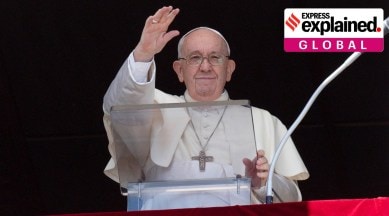Explained: History and significance of Pope’s belongings, now being put up for auction
Signed by the Pope with a black felt-tip pen, the lot is set for sale, starting at $25,000. The bids are being invited till July 16.

A cassock and a silk skullcap worn by Pope Francis, the head of the Catholic Church and sovereign of the Vatican City State since 2013, are being sold by an anonymous consignor on auction platform Heritage Auctions.
Signed by the Pope with a black felt-tip pen, the lot is set for sale, starting at $25,000. The bids are being invited till July 16.
Typically worn by the Pope outside of liturgical functions, we look at the history and significance of the garment, and the previous instances when Pope Francis donated his belongings for charity auctions.
Up for auction
The lot detail by the auctioneer mentions that the cassock is made from “superfine luxury merino wool” supplied by Holland and Sherry in Savile Row, London. It measures approximately 56.5 inches from collar to hem and approximately 21 inches from shoulder to shoulder, and is tailored by “Mancinelli [Clero]”, a shop next to Vatican city.
Although Ditta Annibale Gammarelli, established in 1798, is the official tailor of the Papal office, Raniero Mancinelli has designed garments for three Popes and several priests over the years. The lot is accompanied by two Papal certificates, each signed by Pope Francis’ private secretary, Don Fabio Salerno, confirming that both the cassock and zucchetto are signed by “Sua Santità Papa Francesco”.
Origin and significance of the cassock
A cassock is a long ankle-length cloak that historically derives from the tunic, previously worn under the toga in ancient Rome and the chiton worn under the himation in ancient Greece.
While it is believed that in early Christianity no distinctive garment was worn by the members of the church, by the sixth century the clerics and nobility began to dress in more traditional Roman style of clothing, wearing long tunic and cloak. By the fifth-sixth century, the cassock is believed to have originated in France.
The Fourth Lateran Council in 1215 decreed that clerics must wear garments closed in front and free from extravagance with regard to length, such as long flowing capes.
A priest’s cassock is usually black, though it is also white in tropical climates. Bishops often wear purple cassocks and a cardinal’s cassock is red.
It is believed, the custom of the Pope wearing a white cassock emerged with St Pius V (head of the Catholic Church from 1566 to 1572), a member of the Order of Preachers, who continued to wear his white Dominican Habit.
Worn today by clerics across the world, the cassock comes in a number of styles and cuts. Among others, a Roman cassock most often adorns 33 buttons down the front, symbolic of the age at which Jesus Christ was crucified, whereas an Ambrosian cassock has only five buttons under the neck, with a sash on the waist.
History of the zucchetto
Often worn by Pope Francis, the zucchetto is a type of round skullcap that arguably originated in ancient Greece. Like the cassock, it distinguishes the clergy, and the color of the zucchetto denotes the wearer’s rank. While the highest colour is white, which is worn by the Pope, the cardinals wear scarlet, and the bishops wear amaranth. The priests and deacons wear black. The lower ranking members are supposed to remove their zucchetto in the presence of a higher ranking member.
Made of silk, the zucchetto features eight triangular panels joined to form a circle. Popes, including Pope Benedict XVI and Pope Francis, have often given away their zucchetto as keepsake when gifted with a new one.
Earlier auctions of Pope’s belongings
Belongings of Pope Francis have been auctioned previously too. After being elected by the papal conclave in 2013, Pope Francis has over the years lent support to several charity auctions, also donating his belongings to raise funds.
In June 2020, a racing bike customised with the colours of the Papal States (yellow and white) and the Argentina flag, donated to the Pope by cycling world champion Peter Sagan, was auctioned for € 30,000 as part of the “We Run Together” auction.
In 2018, RM Sotheby’s sold a custom made Lamborghini Huracan RWD Coupe, signed by Pope Francis, for € 715,000. The Huracan was commissioned by Automobili Lamborghini for the Pope, and was presented to him in November 2017. Another ride of the Pope, a 1,585-cc Harley-Davidson Dyna Super Glide, gifted to him by the motorcycle brand in 2013, was auctioned for more than £200,000 in 2014.
A four-door hatchback used by Pope Francis while visiting New York in September in 2015 was sold for $300,000 at an auction in 2016. A supporter of technology, the Pope’s Apple iPad fetched $30,500 at an auction in 2015. The device came with the engraving “His Holiness Francisco. Servizio Internet Vatican, March 2013” and a certificate signed by the Pope’s personal secretary, Fabian Pedacchio Leaniz.